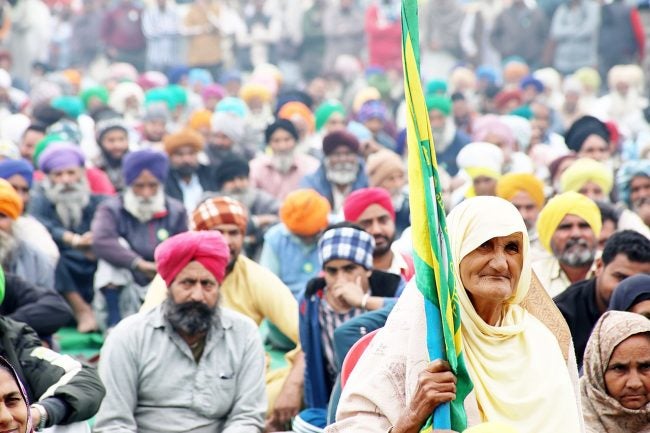Why the Farm Laws were Scrapped: Political Compulsions and More
Ronojoy Sen, Diego Maiorano
29 November 2021Summary
The repeal of the farm laws was a major embarrassment to the Narendra Modi government. While the decision was politically expedient, it highlighted the difficulty of agricultural reform in India.
The decision on 19 November 2021 to repeal the farm laws is without doubt the Bharatiya Janata Party (BJP) government’s biggest climbdown since it came to power in 2014. There were a few occasions earlier, such as the amendment to the land acquisition legislation, where the Narendra Modi government in 2015 had to yield to opposition pressure. In the earlier instance, though, there had not been such sustained protests. The controversial Citizenship Amendment Act, 2019, which also saw widespread protests, has been kept on the backburner, but no formal announcement has been made on its future. In sharp contrast, Modi apologised to the nation for the inability of the government to convince farmers on agricultural reform. The formal withdrawal of the farm laws is one of the items on the agenda of the winter session of parliament, which began on 29 November 2021.
The Political Rationale
The repealing of the farm laws, which were introduced as ordinances and rushed through parliament in September 2020, reveals the strength and weakness of Indian democracy. It shows that sustained protests can work even against a dominant party in power. But it also illustrates the weakness of institutions, in particular the parliament, which led in part to this impasse. If the legislation had gone through normal parliamentary procedures, including committee scrutiny, it might have led to a better law as well as less opposition.
There are a few takeaways from the government’s decision to repeal the farm laws at this current juncture. First, the upcoming elections in several states, including Punjab and Uttar Pradesh (UP), in early 2022 were a key driver. Punjab, Haryana and UP had been the epicentre of the farmers’ protests and they had threatened to impact the BJP’s electoral prospects, particularly in Punjab. By announcing the rollback on one of the most auspicious days for the Sikhs – Guru Nanak’s birthday – Modi attempted to use the symbolism to reach out to voters in Punjab. The BJP has a marginal presence in Punjab having broken off its alliance with the regional Shiromani Akali Dal. However, it sees an opening in the state by tying up with the estranged Congress leader and former chief minister Amarinder Singh. The alliance would not have been possible if the farm laws were still in place.
Second, the 2024 general elections also prompted the government’s decision. The sentiment that the BJP government was anti-farmer had spread far beyond northern India and needed to be dispelled before it became entrenched.
Third, the BJP’s core issues like the construction of the temple in Ayodhya or abrogation of Article 370 tend to consolidate its voter base. But economic or agricultural issues are likely to harm it electorally. Hence, the government is more vulnerable on the latter issues.
Difficulty of Agricultural Reform
From a longer-term perspective, the withdrawal of the farm laws – which, along with the introduction of the Goods and Services Tax in 2017, were the most significant economic reforms of the Modi government since it came to power – show once again how difficult it is to reform the sector.
The economic reforms of the early 1990s left agriculture virtually untouched. Indeed, the present policy architecture – a combination of subsidies on inputs (such as seeds and fertilisers) and outputs (in the form of guaranteeing a selling price to the farmers) – is hardly distinguishable from the one that emerged from the Green Revolution of the mid-1960s. As is often the case, the longer a policy stays in place, the more difficult it becomes to dismantle the network of interests that profit from the system. The remarkable ability of the farmers to sustain a year-long protest amid a global pandemic demonstrates how organised and combative this network is. In addition, farmers’ movements have historically instilled fear in India’s policymakers. In the early 1980s, Indira Gandhi had to make a U-turn on a decision to reduce subsidies on fertilisers, which cannot but remind of Modi’s current decision. In that instance, too, the farmers had been agitating for months throughout the country.
Conclusion
The farm sector in India urgently needs reform. Indian agriculture has been stuck in a state of constant crisis for at least two decades, partly because of low productivity, which in turn fails to attract private investments. Since the early 1990s, the state has also dramatically reduced its support to the sector, particularly in terms of public investments and access to credit. At the same time, the amount of resources for subsidies (mostly regressive) has enormously increased. Furthermore, climate change has a profound impact on Indian agriculture, particularly in areas with poor irrigation.
Indian farmers need concrete policy incentives to diversify their production, abandon environmentally unfriendly farming practices, increase the productivity of their land and adapt to a changing climate. However, the entrenched power of the farmers coupled with short term political compulsions means that it will not be an easy task. The Indian government should start where it failed with the farm laws – by involving the farmers and other stakeholders, including opposition parties, in any future reforms.
. . . . .
Dr Ronojoy Sen is Senior Research Fellow and Research Lead (Politics, Society and Governance) at the Institute of South Asian Studies (ISAS), an autonomous research institute at the National University of Singapore. He can be contacted at isasrs@nus.edu.sg. Dr Diego Maiorano is Visiting Research Fellow at ISAS. He can be contacted at isasmd@nus.edu.sg. The authors bear full responsibility for the facts cited and opinions expressed in this paper.
Photo credit: Wikimedia Commons
-
 More From :
More From :
-
 Tags :
Tags :
-
 Download PDF
Download PDF



